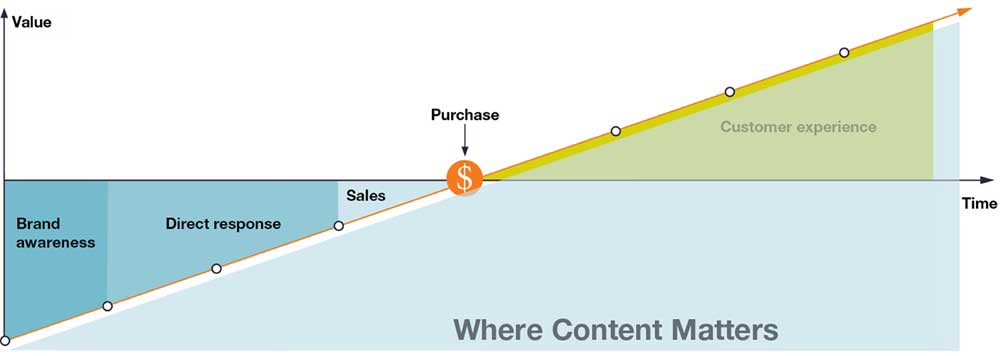Does your content do most of the selling for your company? It should. But if it doesn't, your problem may be rooted in not having a content strategy that mirrors an effective sales funnel.
To ensure that your content reflects enterprise sales processes, consider the following four tips based on best-practices we at the TDA Group use on behalf of large high-tech brands.
1. Content matters throughout the entire B2B buyer's journey
Sales needs to focus on closing, not explaining.
Not too long ago, Marketing was typically responsible for only the beginning stages of the buyer's journey: generating interest, awareness, and leads in the form of names, titles, and phone numbers. Salespeople handled much of the rest. Today, that model has changed dramatically: Potential customers are self-educated about products and services, and they contact salespeople only after defining their requirements on their own, having already made most of their decisions.
Because content fosters understanding, it is critical—especially in markets characterized by complex product offerings:

Content fosters understanding to increase customer value over time.
2. Recognize that the sales funnel is shaped like a content megaphone
Imagine a picture of a traditional sales funnel: wide at the top where you find new leads, narrower in the middle where consideration occurs, and narrowest at the bottom where deals begin to close. Now look at the bottom of the funnel and imagine it as a mouthpiece where thought-leadership content is spoken—and grows and changes in tone and volume as it resonates outward to ever-larger audiences.
Tweets, teasers, and abstracts are the shorter-form content needed for the top end of the megaphone to hook increasingly distracted audiences and draw them into your content stream. Such short, concise bursts of content serve to pique interest and help ensure new leads progress, find interest in your thought-leadership content, and become ready, willing, and even eager to hear it. Tweets and teasers correspond with nascent brand awareness, leading to posts and abstracts, which lead to curiosity in what you have to offer—and compel customers toward deeper engagement and interest in the specifics of your value proposition.
Tweets lead to paragraphs, paragraphs lead to posts, and then posts lead to longer articles and whitepapers. As the funnel narrows, articles, case studies, and brochures integrate with direct responses and conversations. Thought-leadership content, such as whitepapers, supports serious consideration and purchase decisions. Ideally, all this content is premeditated, coordinated, and reinforces an effective messaging theme.

Effective content strategies support the entire span of the sales funnel.
3. Drive all forms of content with thought leadership
Effective B2B social content starts and ends with thought leadership. All those tweets, posts, and articles must have a foundation to be meaningful. Found in your meatiest content such as whitepapers and bylined articles, thought leadership is truly useful and hard to fake. To produce it, you must have genuine subject-matter experts in tune with the challenges that real customers face, and equipped with thoughtful opinions about how to best address those very real customer challenges.
Since that kind of expertise is rarer than it should be, prospects and customers appreciate it when they find it.
When developing thought-leadership content, focus on three crucial qualities:
- Expert. True expertise is genuine and delivers real value. Though it's not possible to fake expertise, there are plenty of examples of arrogance masquerading as expertise. Such feeble attempts aren't just ineffective; they inflict damage upon your brand and make the marketing job even harder.
- Original. Thought leadership must be uniquely yours. Represent the distinctive and timely perspective only your brand has on the industry, marketplace, or other topic at hand.
- Comprehensive. Cover your bases, frankly and honestly. You know those questions your sales team is hoping won't get asked? Your prospects will inevitably ask them, so don't ignore their concerns. Tackle them directly.
4. Remember, the goal is to sell
Ultimately, Marketing has one mission: make sales easy. Sure, awareness campaigns are critical for getting prospects to notice and to become curious about your product or service; but, unless your content informs prospects and leads them toward the point of purchase, some part of your strategy is likely broken, missing, or muted.
Does your content do most of the selling for your company? It should. And as a B2B marketer in today's world, you're on the hook to make it happen.




